How
To Improve Eyesight Without Optical Glasses
Gradual vision deteriation is a common to aging. this
often gradual onset of sensory deprivation can have other
important effects on the brain. It is associated with the
development of mood disorders, and with declines in key
aspects of mental functioning.
"Vision problems are a major public health issues
because they affect so many individuals, and because
they have an adverse impact on our mental health," says
Dennis Norman EdD, Chief of Psychology at Massachusetts
General Hospital. "If the senses are limited, everything
is affected, including interaction with surroundings,
relationships, activities, and feelings of self-worth.
Impairment can lead to depression, anxiety, social isolation
and many other problems."
"That's why evaluating vision and hearing
should be part of any health checkup," Dr.
Norman says. "It's important to catch subtle
changes, because the earlier you treat them,
the better people are able to deal with the impairments." |
Did you know that According to Medical
news Today "People with vision problems
are also more vulnerable to depression and anxiety,
and are less likely to engage in social activities.
Depression is characterized by a low mood lasting two
weeks or more with symptoms such as pervasive sadness,
loss of interest in activities usually enjoyed, feelings
of worthlessness, changes in appetite and sleep patterns,
agitation, fatigue, and suicidal thought."

And In addition to weakening important connections to
the environment, this often gradual onset of sensory
deprivation can have other important effects on the brain.
It is associated with the development of mood disorders,
and with declines in key aspects of mental functioning.
Finding ways to prevent sensory change, and to adjust
to impairments if they develop, is important to maintaining
mental health as we age, according to Massachusetts General
Hospital's Mind, Mood & Memory.
People with partial vision problems may exhibit basic
emotional, cognitive, perceptual, and behavioral, including:
• A persistent, pervasive depressed mood
• Loss of interest or pleasure in usual activities
• Increase or decrease in appetite or weight
• Insomnia or hypersomnia
• Psychomotor agitation or retardation
• Fatigue or loss of energy
• Feelings of worthlessness or excessive/inappropriate guilt
• Impaired thinking or concentration
• Recurrent thoughts of death: suicidal ideas, plans, and attempts
Why Have
you noticed, it seems harder to read things without
your glasses
"The entry point for light is the cornea, the transparent
tissue in the very front of the eye that functions as
the window through which all light has to pass on its
way to forming a visual perception. Next, the light signal
encounters the lens, which focuses it finely on the third
structure of the eye: the retina. The retina is analogous
to the film in the back of the camera. It is on the retina
that the light is converted into a neural signal that
is ultimately interpreted by the brain as an image. Finally,
the optic nerve, which carries these signals to the brain,
functions like a cable that connects the video camera
to the television screen. The deterioration of our vision
with age is invariably the result of a problem with one
of these four structures."

Some Loss of visual function may be caused
by eye conditions that affect the ability to read,
see faces, or travel independently. This loss can
be devastating because of its consequences. Some
individuals may be in jeopardy of losing a job,
while others may be forced to give up driving,
which symbolizes independence and freedom of movement.
Still others may be faced with the prospect of
being unable to cope independently, and may have
to move into a nursing home. It is not unusual
for providers of low vision care to witness depression
among their patients. By Bruce R. Rosenthal, OD,
FAAO |
"The integrity of the corneal surface is very important
for the reception of a clear image. If its surface is
not smooth and intact the image will suffer, much like
the image from a scratched camera. A very thin layer
of tears coats the surface of the cornea. This tear surface,
produced by various cells, some of which line the inner
surface of the eyelid, is vital to maintaining the cornea¿s
smooth surface and precise optical characteristics. Any
condition that disrupts this tear film can lead to a
breakdown of the cornea¿s surface and, thus, degradation
of the image."
Struggling to focus on printed matter is an unfortunate
sign of ageing. Changes to the lens of the eye as you
get older mean you have to move the page further and
further away before you can see properly. It's called
presbyopia and it strikes us all, usually by our mid
40s. And most of us end up having to wear glasses.

"Common Things That
Rapidly Deteriorate Your Vision"
Wearing Glasses and/or Contacts
Some highly respected doctors have stated the following
about the continued use of glasses and contacts:
"Minus lenses are the most common approach, yet
the least likely to prevent further myopic (nearsighted)
progression. Unfortunately, they increase the near-point
stress that is associated with progression."--B.
May, OEP Publications
"I just visited my optometrist
last week because I noticed that my six-month-old
glasses weren't strong enough for me to be able
to see things like road signs. Sure enough, my
vision has deteriorated AGAIN. Six months ago
it was -6.5 (left) and -9.5 (right). Now it is
-6.75 and -10.75. My vision has been getting
steadily worse since I started wearing glasses
in kindergarten (I'm 23), but lately the right
eye in particular has started to worsen faster,
at least -1 per year" Source |
"The emphasis on compensatory lenses
has posed a problem for many years in our examinations.
These lenses do not correct anything and may not serve
the patient in his best interests over a period of time."--CJ.
Forkiortis, OEP Curriculum
"Single-vision minus lenses for full-time use produce
accommodative insufficiency associated with additional
symptoms until the patient gets used to the lens. This
is usually accompanied by a further increase in myopia
and the cycle begins anew."--M.H. Birnbaum, Review
of Optometry.
| When your eyes are placed behind normal
prescription glasses, you fall into a trap where
you no longer use the focusing muscles in your
eyes to the full. This important muscle begins
to weaken, requiring visits to your eye doctor
for stronger and stronger glasses. You can reverse
this downhill slide and help develop your eye
muscles now by using pinhole glasses. |
Now, glasses are a great fix for many people,
but the fact is they are a crutch. Glasses do not repair
your vision. They simply put a band-aid over the condition.
The fix that fails kids' eyes
23 November 2002
Andy Coghlan Michael Le Page
Magazine issue 2370
The standard prescription for correcting children's short sight
actually seems to make their eyes deteriorate faster. And it has
been used routinely for decades
MILLIONS of people worldwide may have worse eyesight and even be
more likely to go blind because of a long-held but misguided idea
about how to correct short-sightedness. A study intended to confirm
the theory has instead been stopped because the children's eyesight
was getting worse, New Scientist has learned.
For decades, many optometrists have been routinely "undercorrecting" short-sightedness,
or myopia, when prescribing glasses or contact lenses. "What
was done was done with the best of intentions," says optometrist
Daniel O'Leary of Anglia Polytechnic University in Cambridge, England.
Indeed, his study of 94 children in Malaysia sought to prove the
value of undercorrection. Instead, it showed the opposite.
While the number of children involved
was small, amazingly it is the largest and most
rigorous study to date. "The study was meant
to run for three years but after two years, when
we found out we were making the children's eyes
...
The
complete article is 861 words long. |
Have you ever gone in for an eye-exam and
had the doctor say: "great news, your vision improved
another 2 diopters. Looks like you need a lower prescription."
I didn't think so!
| Millions of people have eye problems,
ranging from slight blurriness to near blindness.
Most think there is nothing they can do about
it, but for some conditions, there are methods
that can help strengthen eye muscles. |
Aging
This is as inevitable as the sun rising in the morning.
You can't stop aging, but you can prevent the negative
(and sometimes downright cruel!) effects that it causes.
When you age, the internal components of your eye become
stiff and rigid, losing their flexibility. These components
are responsible for focusing the images that enter your
eye.

Because they become stiff and rigid, they cannot fully
focus as they did when you were younger. Suddenly everything
within an arm's length becomes blurry and you're rewarded
with your first pair of reading glasses.

The bad news is it only gets worse with time!
The good news is you can do something to prevent it
and improve upon it.
What would you do if the muscles in your legs became
so stiff that you couldn't walk or run?
You would stretch them of course!
The same principle applies to the components inside
your eye. All they need is to regain the flexibility
they once had.
This is easily achieved through specially designed pinhole
glasses that exercise your eyes
| A Person with poor eyesight can wear glasses or
contact lenses. How often, though, does he/she look
inside themself for ways to improve? |
Using the
Computer
Like millions of people, you are likely experiencing
one or more of the following symptoms right now:
•Headaches
• Back/neck aches
• Spasms/twitches around the eyes
• Dizziness
• Lightheadedness
• Car sickness
• Nausea
• Blurred vision
• Double vision
|
• Tired or sore eyes
• Dry eyes
• Watery eyes
• Itchy eyes
• Burning eyes (even when closed)
• Heaviness of the eyelids/forehead
• Fatigue
• Reading problems
• Lack of concentration
|
The treatment of these symptoms represents more than
3 billion dollars to the optical industry every year.
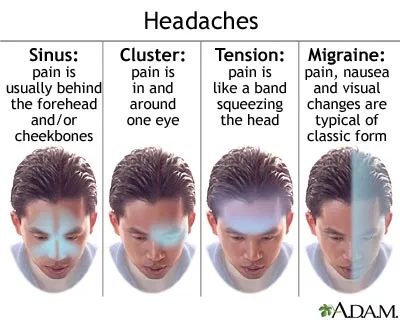
And, prolonged computer use without incorporating some
simple habits into your life can cause permanent damage
to your distant vision.
Every hour you spend on the computer can contribute
to vision loss. Computer use causes "near
point stress," and the permanent effects of
it, not to mention many other things such as decreased
blink rates and insufficient tear flow which leads to
dry, burning eyes.
Not Exercising Your Eyes
Just like your body, your eyes can be strengthened.
Specially designed pinhole glasses can reverse the cycle
of deterioration your eyes experience everyday, and dramatically
improve the clarity of your vision.
Here’s how they work:
Your eyes focusing abilities are controlled by a series
of internal muscles.
If your eye muscles are not properly maintained, they
can breakdown just like the other muscles that help your
body function.
Due to many stresses put upon the visual system, the
use of glasses and contacts, close vision work, and the
natural aging process the eye muscles become weak, rigid,
and distorted, causing blurred vision.
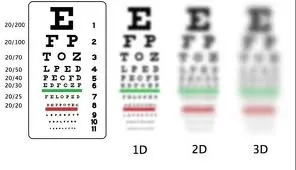
Special pinhole glasses are designed to strengthen and
train these muscles just as you would any other weak
muscle in your body and redirect your point of focus,
helping you to see clearly without corrective lenses.
These Special pinhole glasses stimulate the integral muscles of the eye
in a manner that would never be achieved through normal daily use. They
are proven to dramatically help conditions such as:
1) Aging Vision
2) Nearsightedness
3) Astigmatism
How to Tell if Your Eyes
Are Going Bad
 |
Get
your eyes tested regularly by an ophthalmologist
or optometrist. Once a year is standard. If any
of the following are a problem, you may wish to
schedule an appointment sooner. |
Look at an object
that is far away that you tend to see a lot. If
it looks blurrier than you remember, or you just
think you have trouble seeing things you once could
see easily, your eyes probably aren't as good as
they used to be. |
|
|
Look really closely
at something. A book or newspaper will work. If
you have trouble reading the print, your eyes probably
aren't as good as they used to be. But this is
true only if you at one point were able to read
the print, obviously. |
How to Strengthen
How They Work.
Pinholes provide an infinite depth of focus so that even when the eye
is not correctly focused, objects will appear as if in focus. Importantly
they eliminate scattering of light to the retina and hence improve
vision.
The idea behind pin-hole glasses is not
new. It was known centuries ago and was used before the
advent of glass lenses. The reason they work is simple. "Light
passing through a small hole (or holes) is restricted
to rays coming straight from the viewed object; these
rays do not need focusing to bring them to a point," according
to Drs. Russell S. Worrall and Jacob Nevyas in The Eye
Exorcisors published in The Health Robbers.
Just look through any pin-hole and you'll
see what they mean. When you do this, blurred images
become focused. This is because the amount of peripheral
light rays (which are responsible for blurring) is reduced.
With appropriately spaced multiple pin-holes, you'll
get clear straight vision without the difficulty of concentrating
on a single hole. Regular use of these special pinhole
glasses helps exercise eye muscles and helps eyes relax
at the end of a tiring day and thus has a beneficial
effect. Particularly useful for those who spend a great
deal of time looking at computer and/or TV screens, Pinhole
Glasses help retrain your eye muscles, just as other
forms of exercise retrain muscles elsewhere.
a. It is not known who invented
the pinhole glasses, but the scientific principles
of pinhole effects were discovered many centuries
ago. Pinhole glasses are widely sold in America,
Europe and Australia as substitutes to prescription
glasses since the 1950’s at least.
b. The basic optical principles of
the pinhole are commented on in Chinese texts from
the fifth century BC. Chinese writers had discovered
by experiments that light travels in straight lines.
The philosopher Mo Tsu was the first – to our
knowledge – to record the formation of an inverted
image with a pinhole or screen.
c. Aristotle (fourth
century BC) comments on pinhole image
formation in his work Problems. d.
Sir David Brewster, a Scottish scientist,
was one of the first to make pinhole
photographs, in the 1850s.
|
How pinholes function. Pinhole glasses
(also known as stenopeic glasses from the Greek words
for "little opening") are not made of glass
at all but of an opaque substance such as metal or plastic.
The user looks through any of the many small holes in
the material. These holes have the effect of reducing
the width of the bundle of diverging rays (called a "pencil
of light") coming from each point on the viewed
object. Normally, the full opening of the pupil admits
light. It is the improper bending of the outermost rays
in that pencil of light which causes refractive errors
such as myopia, hyperopia (farsightedness), presbyopia
(diminished focusing range with age) and astigmatism
to be noticeable. Pinholes can bring about clearer vision
in all these conditions. By blocking these peripheral
rays, and only letting into the eye those rays which
pass through the central portion of the pupil, any refractive
error in the lens or cornea is not noticed as much. The
pupil may be wide open, but only the central portion
is receiving light. The improvement in visual acuity
can be striking.
| Also of interest is that the farther away the
viewed object is, the less the pinholes are noticed.
The honeycomb effect of the holes is more noticeable
when viewing a book held close to the eyes, because
the eyes are focused just a short distance in front
of the glasses. When looking at a distant TV, however,
the holes are hardly visible at all since the eyes
are focused much farther away. Also, because of
the distance, you can view the entire TV screen
through one hole, an obvious benefit. |
Look at this drawing of a myopic eye with a pinhole
lens in front of it. You will see that the eye does not
need to deal with the rays that would need the most bending
since they are blocked by the lens. It is said that Scheiner
first described this effect in 1573. Those who are familiar
with cameras will recognize that this is the same principle
used to increase the depth of focus by decreasing the
aperture. Pinhole cameras also operate by this principle.
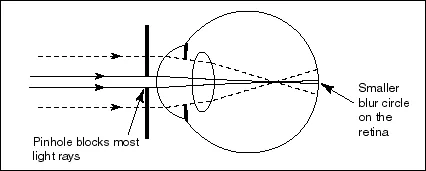
Why
did some Govt Depts try to have them Banned
 As
we get into our 40's and 50's and presbyopia (inability
to focus close) develops, pinholes provide a simple and
inexpensive solution for reading or other close work. As
we get into our 40's and 50's and presbyopia (inability
to focus close) develops, pinholes provide a simple and
inexpensive solution for reading or other close work.
 Bifocals
or trifocals are designed to provide a clear image only at fixed
distances. Pinholes provide an improved image at ALL distances. Bifocals
or trifocals are designed to provide a clear image only at fixed
distances. Pinholes provide an improved image at ALL distances.
 In
many applications, such as alternating between
watching TV and reading, they can easily take the
place of those very expensive prescription lenses In
many applications, such as alternating between
watching TV and reading, they can easily take the
place of those very expensive prescription lenses
| REMARKS OF AMERICAN DOCTORS
Dr.
Janet Goodrich(a distinguished eye-sight-correcting
specialist)
" People with both close and distant blur and astigmatism are able to use
micohole sight correctors."
Dr.
David Michael(author of Visual Optics and Refraction)
" Microholes reduce aberrations and light scattering, isolate a favorable
area of the damaged cornea and increase depth of focus."
Dr.
Norman Bies(author of Correction of Subnormal Vision)
" The longer depth of focus obtained through microholes is well established
--- patients enjoy a substantial increase in reading distance."
|
 Multi-focal
lenses provide a continuously variable curve that is
supposed to give good vision at all distances. In reality,
the distortion on either side of the center line is considerable
and often too great for comfortable use. Pinholes eliminate
this problem. Multi-focal
lenses provide a continuously variable curve that is
supposed to give good vision at all distances. In reality,
the distortion on either side of the center line is considerable
and often too great for comfortable use. Pinholes eliminate
this problem.
 There
is no need to continually throw away old glasses and buy new,
stronger ones. Unless the pinholes break, they can be used an
entire lifetime. There
is no need to continually throw away old glasses and buy new,
stronger ones. Unless the pinholes break, they can be used an
entire lifetime.
| Printable
eye charts you can download and print for
home use to determine your visual acuity ie. 20/20
vision.
To print out the eye chart below press the
printer friendly link at the top of this page
or download the eye chart, save it to your desktop,
and print it from there.
Due to differences in monitor size and resolution,
this test is not accurate when viewed on a computer.
 Be
sure you select these options on your printer
- Be
sure you select these options on your printer
-
 Maintain
aspect ratio, Maintain
aspect ratio,
 Use
full page, Use
full page,
 Center
image on page. Center
image on page.
The Eye Chart is read while standing 20 feet from the chart. Be
sure the room you are in is well lit but is not in full sunlight.
Test one eye at a time (cover the other eye
with your hand or card etc.). The lowest line
that you can read correctly is your visual acuity.
At 20 feet (6 meters) you should try to read
the letters on the row 6th from the top. If you
can read that line ok it means you have visual
acuity of 20/40 or better: 1/2 normal.
Standing at 10 feet from the eye chart if the
smallest letters you can read were on the 6th
row from the top, this would give you an acuity
of 10/40: 1/4 normal.
If you are nearsighted, your vision will become
clearer the closer you stand to the eye chart |
 While
pinholes are considerably cheaper than individual prescription
glasses. For example, a person who is a little nearsighted
but only needs clear distant vision for occasional TV
viewing would find pinholes a cheaper solution than prescription
glasses. While
pinholes are considerably cheaper than individual prescription
glasses. For example, a person who is a little nearsighted
but only needs clear distant vision for occasional TV
viewing would find pinholes a cheaper solution than prescription
glasses.
 Off-the-rack
reading glasses have the same lens power in each lens.
Some people find these cheap glasses unsuitable because
the refractive error in each eye is not the same. Pinholes
are ideal for such people because these glasses do not
require a similar refractive error in each eye. Off-the-rack
reading glasses have the same lens power in each lens.
Some people find these cheap glasses unsuitable because
the refractive error in each eye is not the same. Pinholes
are ideal for such people because these glasses do not
require a similar refractive error in each eye.
| Claims that pinhole glasses can permanently
improve vision are related to claims for the Bates
Method of natural vision improvement. The Bates
Method teaches people to see only one small point
clearly at a time, to quickly scan across an image
instead of staring and seeing the entire image
clearly without moving the eye |
 There
is a pincushion effect when looking through the edges
of prescription glasses. That is, straight lines appear
curved. This disturbing effect does not occur with pinholes There
is a pincushion effect when looking through the edges
of prescription glasses. That is, straight lines appear
curved. This disturbing effect does not occur with pinholes
| Do your eyes get tired and strained even when you're
wearing your glasses? Simply clip these pinhole glasses
onto your regular glasses. The scientific "pinhole" technique
trains your eyes to focus better, strengthening the
eye muscles. You can read, watch TV or do handwork
with less strain. The tinted lenses also reduce annoying
glare. Wearing pinhole clip-ons just
15 minutes a day may even reduce your need for prescription
eyeglasses. More |
 When
you lay prescription glasses down improperly, they can
easily get scratched at the center of the lens, the very
area you have to look through. Scratching pinholes has
no effect on their performance. When
you lay prescription glasses down improperly, they can
easily get scratched at the center of the lens, the very
area you have to look through. Scratching pinholes has
no effect on their performance.
 Pinholes
do not have to be cleaned of fingerprints and other marks that
affect vision. Pinholes
do not have to be cleaned of fingerprints and other marks that
affect vision.
 Many
parents will not allow their children to use bifocals
to reduce the stress of close work because such
glasses are for "old people." Many
parents will not allow their children to use bifocals
to reduce the stress of close work because such
glasses are for "old people."
 Pinholes
are an easier thing to accept because they are
the same for all ages. Pinholes
are an easier thing to accept because they are
the same for all ages.
 Many
people who have had corneal surgery find that their
night vision has permanently deteriorated. Glare
is a problem. They see halos and "starbursts" around
lights. Even in normal home lighting they have
problems so that they get in the habit of turning
on as many lights as possible in order to get a
small pupil and reduce the visual problems. Pinholes,
either conventional or Snap-ons, can deliver the
same small pupil without increasing the electric
bill. Many
people who have had corneal surgery find that their
night vision has permanently deteriorated. Glare
is a problem. They see halos and "starbursts" around
lights. Even in normal home lighting they have
problems so that they get in the habit of turning
on as many lights as possible in order to get a
small pupil and reduce the visual problems. Pinholes,
either conventional or Snap-ons, can deliver the
same small pupil without increasing the electric
bill.
 Physics
instructors from Ludwig-Maximilians University in Munich,
Germany, and Kansas State University in the United States
wrote in a 2008 "The Physics Teacher" article
that "modern promoters claim that pinhole glasses
are better than conventional lenses in correcting all
kinds of refractive defects such as myopia (nearsighted),
hyperopia (farsighted), astigmatisms, and presbyopia." Their
investigation of the short-term and long-term effects
of using pinhole glasses showed temporarily corrected
sight. Physics
instructors from Ludwig-Maximilians University in Munich,
Germany, and Kansas State University in the United States
wrote in a 2008 "The Physics Teacher" article
that "modern promoters claim that pinhole glasses
are better than conventional lenses in correcting all
kinds of refractive defects such as myopia (nearsighted),
hyperopia (farsighted), astigmatisms, and presbyopia." Their
investigation of the short-term and long-term effects
of using pinhole glasses showed temporarily corrected
sight.
 Children
with special needs often use only their peripheral vision,
and pinhole glasses help them concentrate on detail better.
It has been found that the pinhole glasses help improve
acuity and central macular vision.. Children
with special needs often use only their peripheral vision,
and pinhole glasses help them concentrate on detail better.
It has been found that the pinhole glasses help improve
acuity and central macular vision..
| USING
YOUR PINHOLE GLASSES
Pinholes are best worn when watching TV
or reading. When reading always make sure adequate
lighting is supplied. As you look through Pinholes
some light is cut out. Pinholes are also excellent
for computer operators. Computer screens tire
and strain eyes rapidly, Pinholes, allow your
eyes to relax.
Your eyes may take a little while to adjust
to Pinholes, but in a short period your eyes
will not notice that they focus through these
tiny holes. That is why watching TV is ideal,
you forget very quickly that you are wearing
them.
Pinholes should be worn for a few hours
a day, or as often as possible.
Never wear your Pinholes when driving or
doing any activity where sideways vision is
required. Do not use as sun glasses. Always
make sure your Pinholes are clean and check
no holes are blocked, it is very important
to have complete vision
|
 In
cases of retinal separation, unnecessary motion of the
eyeballs should be avoided. This can be accomplished
by blocking all but the central pinholes, forcing the
user to turn the head rather than the eyes. In
cases of retinal separation, unnecessary motion of the
eyeballs should be avoided. This can be accomplished
by blocking all but the central pinholes, forcing the
user to turn the head rather than the eyes.
 Many
people with cataracts see better through pinholes. A cataract
is one or more opacities in the lens that do not allow the light
to pass through properly but instead cause it to scatter. By
cutting off the peripheral rays, pinholes can reduce some of
this scattering and improve Many
people with cataracts see better through pinholes. A cataract
is one or more opacities in the lens that do not allow the light
to pass through properly but instead cause it to scatter. By
cutting off the peripheral rays, pinholes can reduce some of
this scattering and improve
| Some of the vision problems that are said to
be helped by pinhole glasses are : myopia (nearsightedness),
hyperopia (farsightedness), presbyopia, astigmatism,
and computer vision syndrome. These glasses are
not intended for driving and should not be used
at those times. People have reported that they
are helpful in reading, when dimestore readers
are not enough and prescription glasses are too
expensive. Also, it has been reported that pinhole
glasses are helpful for those who do computer work
in brightly lit offices. They are said to reduce
fatigue and eyestrain in this work. |
Stenopeic
(Pinhole) Glasses - The Evidence
by James E. Lebehsohn, M.D. Ph.D., Chicago
Introduction:
Glare protection for eyes dates back to prehistoric
time. Some devices were made of bone, wood or hide, and
had slits in them to protect the eyes from the glare
of the sun, snow or sea water. These were tied round
the head with strips of hide. Today a scientific version
of the glare interceptor, called by the distributor Stenopeic
(multiple-pinhole) spectacles in which 7 rows of pin-holes
of specific size and spacing are placed in a plastic
opaque material are available. These, after much experiment,
were found to be valuable in certain cases of subnormal
vision. A few examples follow of the conditions in which
they have been used successfully.
Complicated Cases
Recently a case was brought to my attention. It involved
a young serviceman whose eyes had been injured by sulfur
dioxide gas. Both corneas had been transplanted and his
vision, uncorrectable with glasses, was 20/400 in each
eye -which meant he was nearly blind.
After studying the case I recommended he be given stenopeic
spectacles. With these, vision was improved to 20/70
and he could read 9-point type.
A 70 year old stockbroker had a mature cataract in his
left eye and nuclear sclerosis with a small cupuliform
opacity in his right crystalline lens. Stenopeic spectacles,
by removing the disturbing veiling glare, gave him 20/30
distant vision and permitted 4-point type to be read
without difficulty.
Other Complicated Cases
A recent case was most unusual. A 47-year old man had
been disturbed for the past two years by seeing distant
objects doubled through his only good eye. The other
was amblyopic and markedly divergent.
He consulted a qualified ophthalmologist who was puzzled
and referred the patient to me. On refracting his seeing
eye, I found he had excellent correctable vision, but
even with correction he still noted a doubling of the
hands on the large clock across the street and the red
dots below the numbers on the dial. With stenopeic spectacles
he was delighted to see everything sharp and with no
doubling.
Excellent Results
A man of 58 had unaided vision of right eye 20/13, left
eye 20/300. A diffuse posterior subcapsular cataract
was present in his left eye. With pinhole spectacles
the vision of this eye was 20/30 though no lens gave
any improvement.
An appraiser of 56 had a left mature cataract and a
right incipient cuneiform cataract. The right acuity
was 20/40, unimproved by lenses. He had been wearing
pinhole spectacles successfully for two years, achieving
2030 vision without veiling glare. He can read 4-point
type with a hand magnifier.
A man of 46 had bilateral cataracts. On September 23,
1952, with mydriasis, vision was correctable by glasses
to right 20/30, left 20/20. On August 1, 1953, his vision
with these glasses had diminished to right 20/70, left
20/40. I then recommended pinhole spectacles. With these
his distant acuity was 20/25 in both eyes and he could
read 4-point type.
More Examples of Successful
Applications
There are numerous cases in which pinhole vision far
exceeds that obtainable by lenses. Usually, excellent
pinhole vision is indicative of good operative prognosis,
but by utilizing pinhole devices, the imperative necessity
for surgery may frequently be delayed. In the past five
years I have found the following uses for pinhole spectacles.
1.In irregular astigmatism, conical
cornea, discrete corneal opacities and incipient cataract,
the pinholes often permitted clarity of vision not obtainable
by lenses.
2.As a temporary expedient the pinholes are
valuable for children with high astigmatism until the become
sufficiently co-operative for objective refraction.
3.As the pinholes help both distant
and near vision they can be used by those who have
broken their glasses while waiting for new lenses.
4.Following cyclopedia, which
induces a temporary paralysis of accommodation,
the pinhole provides protection from glare and
compensates for the disturbed visual acuity.
5.In pathologic photophobia-discomfort
the pinholes frequently reduce light to a comfortable
degree and yet permit effective vision.
6.In cases of retinal separation
the motion of the eyeballs can be controlled adequately
by blocking all but the central pinholes.
7.Used by patients after cataract
extraction, before receiving new glasses, the pinhole
spectacles add an element of protection besides
their own advantages. In none of the cases in which
pinhole spectacles were used have I found any adverse
effect, and I feel that in time acceptance of this
aid will increase among the populace.
The following
extract is taken from "The Optometrist's Handbook
of Eye Diseases", written by Joseph I. Pascal
and Harold G. Noyes.
AS YOU
CAN SEE AMAZING EFFECT EXPERIENCED BY THE WEARERS
IN THE FIRST PLACE
You will see objects clearly through
the pinholes drilled in the lenses. Even those who have
near-sightedness, farisightedness, astigmatism, or amblyopia
can see objects clearly through the small holes. In this
case, the eyeball muscles of the wearer get normalized
by themselves and the focus of the eyeball(the crystalline
lens) is adjusted. The pinholes are small plain holes.

AFTER A SHORT PERIOD
If you look at things without the glasses
after wearing them for about half an hour, you will be
surprised that you can clearly recognize even very small
letters.

AFTER A SHORT TIME
If you persist in wearing these glasses
only a couple of hours a day while reading books or newspapers,
or watching TV, and your eye problems are not hereditary,
you will succeed in your sight-recovering exercise, and
the eyeball muscles and cystalline lenses will be normalized.(You
may not need glasses at all)
How
to exercise your eyes with Pinhole Glasses
| STEP 1. Rotate
your eyes from triangle to triangle in a clockwise
direction, 10 time or more. Then repeat in an anti-clockwise
direction |
STEP 2.
Move your eyes from side to side between the triangles,
10 times or more. This action simulates Rapid Eye
movement.
|
STEP 3. Take a magazine
or book. Hold it at arms length and choose one word.
Concentrate on this word and slowly move your arms
towards your eyes as closely as you can focus. Then
slowly move to arms length again, still concentrating
on your chosen word. Repeat 10 times or more.
|
Pinhole glasses are not for everyone. It is possible
that certain eye conditions are too severe to be helped
and many doctors are reluctant to actually endorse them.
However, there are many, many years of anecdotal evidence
and user testimonies. Some people feel that their vision
has even been improved by using these lenses.Some people
claim that they are helpful in delaying the need for
cataract surgery and it is also suggested that they can
slow the progresion of myopia. While all claims have
not been proven at this point, certainly there is enough
user information to help you decide to try pinhole glasses
for yourself.
It is important if you do obtain pinholes
that you give yourself some time to adjust to them. Put
them on, do some yawning, blinking until your brain says.
'This super clear vision is all right'. At this point
the brain stops paying attention to the black occluding
plastic and tunes into the messages coming through the
pinholes

Looking through
the teeth of a comb held in front of the eyes is
another way to simulate
the pinhole effect. The native people of Alaska have
long used this principle by wearing glasses with
narrow slits to look through, thus blocking out much
of the glare from the sunshine reflecting off the
snow and ice. |
Anyone who remains in this environment for long
periods during the summer without protection can
suffer from snow blindness
.This painful condition
forces the person to discontinue the use of the
eyes until healing
can take place. This is nature's way of protecting
the eyes from permanent damage
|
|
Pinhole Glasses

please
note these are not the cheap version from china,
these are made in Korea by an eyeware company,
these are high quality end of run glasses frames
with pinhole lenses inserted,
|
|
|
 |
Bifocals or trifocals are designed
to provide a clear image only at fixed distances.
Pinholes provide an improved image at ALL distances
suitable for both men and women
Click
here for more infomation and ordering |
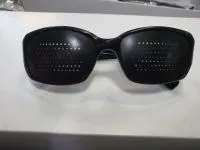 |
"Join the Thousands of People Worldwide that
have Helped Their Vision Naturally!"
suitable for both men and women
Click
here for more infomation and ordering |
 |
In many applications, such as alternating between
watching TV and reading, they can easily take the
place of those very expensive prescription lenses
suitable for both men and women
Click
here for more infomation and ordering |
 |
"Join the Thousands of People Worldwide that
have Helped Their Vision Naturally!"
suitable for both men and women
Click
here for more infomation and ordering |
 |
Pinhole glasses are used in many hosptitals to
test your vision
suitable for both men and women
Click
here for more infomation and ordering |
 |
As we get into our 40's and 50's and presbyopia
(inability to focus close) develops, pinholes provide
a simple and inexpensive solution for reading or
other close work.
suitable for both men and women
Click
here for more infomation and ordering |
 |
"Pinhole glasses are sometimes used to treat nearsightedness
or astigmatism, eye doctors are often the primary
users. Eye doctors often use pinhole glasses as a
diagnostic
tool to quickly check for vision impairments."
suitable for both men and women
Click
here for more infomation and ordering |
We do not imply that
you can throw away your prescription glasses. By continued
wearing, pinhole glasses have been
know to totally or partially correct vision problems.
Treatment time will vary with the condition of the users
eyes and total wearing time.

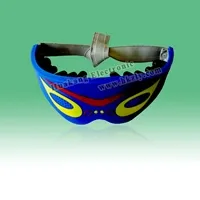
Frequency Specific
Microcurrent Stimulation Eye Mask
|
Eyemate
ver 3
Frequency
Specific Microcurrent and PEMF Stimulator
 Fully
Rechargable Fully
Rechargable
 Charger Charger
 Intensity
Control Intensity
Control
 Frequency
Specific Microcurrent PEMF Stimulation Eye
Mask included Frequency
Specific Microcurrent PEMF Stimulation Eye
Mask included
 Full
Instructions Full
Instructions
 Frequencies INCLUDED
:) Frequencies INCLUDED
:)
5Hz, 292 Hz, 292.7Hz ,30 Hz, 30.7Hz,9.1
Hz 9.8Hz and 0.3 Hz ,10hz , 0.7 Hz,, 14Hz 1.5Hz,
3.6 Hz ,95hz 137 Hz, 18Hz 1.5hz, 3.6 hz, 137Hz,
1Hz
 Each
frequency will run for aprox 24 sec. Each
frequency will run for aprox 24 sec.
|
Sources |

